Emre İşçi1, Fatma Ayanoğlu Şişman2, Gülfer Bektaş3
1Marmara University, Health Science Faculty, Istanbul, 34470, Turkey
2Marmara University, Management and Organization Department, Istanbul, 34470, Turkey
3Acıbadem University, Health Science Faculty, Istanbul, 34470, Turkey
Correspondence to: Fatma Ayanoğlu Şişman, Marmara University, Management and Organization Department, Istanbul, 34470, Turkey.
| Email: |  |
Copyright © 2012 Scientific & Academic Publishing. All Rights Reserved.
Abstract
In recent years some philosophical concepts are being used to understand and explain the relationship between the employees and the organizations. Cynicism, as being one of these concepts, reflects the employees’ negative perceptions and attitudes against the organizations they are working for. Some studies on this specific issue reveal the fact that organizational disappointment decreases in the presence of some organizational dynamics. In this research, personnel empowerment by means of which all the authority and responsibility of work is granted to the person who is performing it as well as the opportunity to use initiative when needed and its impact on organizational disappointment is evaluated. For this purpose a sample including 140 employees working in hospitals has been developed to achieve results in relation to the aim of the research. The results of the research prove the fact that personnel empowerment decreases the level of organizational disappointment (r=-0,40; p<0,05). In the regression analysis conducted, it has been found out that personnel empowerment explains 16% of organizational disappointment and thus other organizational dynamics and variables are needed to explain cynicism.
Keywords:
Empowerment, Management, Cynicism, Organization
Cite this paper: Emre İşçi, Fatma Ayanoğlu Şişman, Gülfer Bektaş, A Research on the Relationship between Personnel Empowerment and Organizational Cynicism, Management, Vol. 3 No. 5, 2013, pp. 252-258. doi: 10.5923/j.mm.20130305.02.
1. Introduction
The concept of empowerment has been studied and examined in terms of efficiency and performance increase in businesses. Recent studies demonstrate the fact that personnel empowerment has positive impact on employees and studies have begun to be carried out more frequently. Empowerment not only helps build employee self-esteem but also develop positive feelings and attitudes towards the businesses. Consequently, the possibility of individual turnovers decreases while the employees’ commitment to the employing organizations and their work performance increase. Cynicism is the negative attitude developed by the individual against the employing organization. One of the most important purposes of a management is to ensure the full competence and efficiency of its employees. It is an obvious fact that the cynic individuals will have lower efficiency and performance levels. Considering the situation one needs to ask how one can remove cynicism. In this respect, the aim of the researcher is to find out whether there is a relationship between organizational cynicism and personnel empowerment or not and if there is such a relationship to define the level personnel empowerment affects organizational cynicism and whether it decreases or increases cynicism. In this article first of all the concepts of empowerment and cynicism will be evaluated and the research period, the findings obtained throughout the research and solution suggestions will be given in detail.
2. Empowerment
Today’s intensely competitive working conditions require new managerial approaches as traditional management mentality proves to be inadequate. One of these approaches is empowerment. Empowerment is about the personnel’s authority and decision making responsibility they have on the work they are performing in an organization where the concept of personnel is developed on the very basis of power. Therefore it would be helpful to evaluate the concept of power briefly.According to Weber power is the ability of a person to make his or her will accepted in a social relationship even against the resistance of others[1]. From another perspective power is the ability to have something done even against the resistance of others.[2] In this respect empowerment is a concept through the implementation of which a person gains power on issues considering the work he or she is obliged to perform. In organizations empowerment means granting authority and power to the employees to ensure that they are capable of doing the things that they have not been able to do so far in relation to their work.[3] Similarly, conditions in which employees are motivated, believed in their qualifications and encouraged to use their own initiatives indicate the existence of empowerment.[4]Empowerment is in fact a period through which seniors share their power with juniors or subordinates and seniors transfer their authority of power and control to juniors who have relatively less power and control in the organization. It would not be wrong to state that this period enhances the employees’ commitment to the organization as well as their motivation and has a positive impact on organizational elements in the long run[5].Empowerment is most of the time considered to have the same meaning with the concept of “authorization” and is even used interchangeably with the concept of authorization. However, empowerment means assigning the employee with authority, power and responsibility in relation to the work he or she is supposed to perform and unlike authorization in the act of empowerment such authority, power and responsibility is not withdrawn, it is of permanent nature[6].
3. Cynicism
There are two views about the origin of the concept of cynicism[7].According to the first view cynicism derives from the Greek word “kyon” which means dog. Cynical individuals prefer a natural life, do not conform to social rules, do not care for their clothing and wander around slatternly and despise what others call civilization. Therefore, the metaphor of “kyon” (dog) has become the symbol of cynics who display unconventional and unusual behavior. According to the second view it has been suggested that the concept derived from the word “Kynosarges” (gymnasium) where Cynics school was located in. Organizational cynicism represents an attitude which can be associated with a number of things and which can make generalizations between different targets and a learned belief which develops through experience. In this respect, the concept of organizational cynicism is defined by James as “a type of cynicism associated with attitudes against the employing organization which the individual perceives with negative beliefs, feelings and reacts accordingly; organizational cynicism is the response to the past personal and social experiences which are likely to change as a result of environmental factors.”[8]Different definitions for cynicism:[9]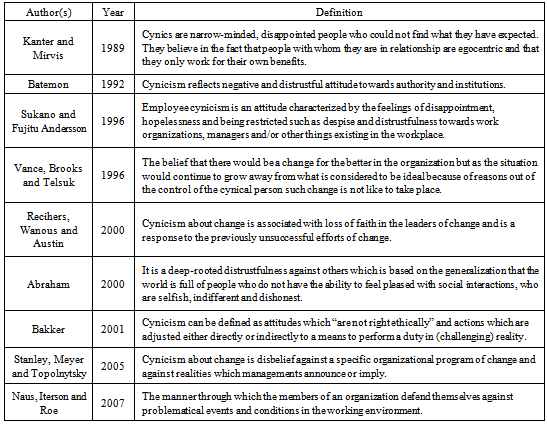 While defining the concept of organizational cynicism, Mirvis and Kanter pointed out the fact that organizations can be cynical as well. They described cynical organizations as “organizations which apply deceptive and exploitive implementations, develop unilateral relations with their employees, behave in a quick-tempered manner, support administrators who follow a hypocritical policy against their employees and materialize values selfishly.”[10]Types of Cynicisma) Dispositional CynicismDispositional cynicism is the pathopsychological variable of organizational cynicism. This type of cynicism is also figured in “Cook-Medley Hostility Scale”. This invariable idiosyncrasy is defined as cynicism against any kind of human behavior (Dalken, 2004: 17). In dispositional cynicism the person behaves hostile towards others and question people’s attitude towards himself even if they have good intentions. b) Employee CynicismEmployee cynicism is mainly targeted against big capital owners, senior management and other persons or departments in the work place. The feeling of inequality separates the cynical employee from other employees. This feeling of inequality occurs when the formal employment contract between the employer and the employee is violated as in the violation of psychological contracts between the employer and the employee, which implicitly promise equality, justice and objectivity[11]. c) Work CynicismWork (Occupational) Cynicism is usually associated with service sector personnel who are believed to experience clash of roles and uncertainty about their roles[12].d) Social CynicismSocial or Institutional cynicism is about the distrustful attitude of citizens against their states or institutions. Social/Institutional cynicism occurs as a result of the violation of the psychological contract between the individual and the society[13].e) Organizational Change CynicismCynicism about organizational change is defined as “pessimistic views about the efforts of organizations to change and reach the targeted success”[14].f) Organizational CynicismOrganizational cynicism is usually associated with the employees’ excessively negative attitudes towards the employing organizations. In organizational cynicism the employee despises the management, accuses it of selfishness, insults and despises his or her colleagues (Dean and others, 1988: 345).
While defining the concept of organizational cynicism, Mirvis and Kanter pointed out the fact that organizations can be cynical as well. They described cynical organizations as “organizations which apply deceptive and exploitive implementations, develop unilateral relations with their employees, behave in a quick-tempered manner, support administrators who follow a hypocritical policy against their employees and materialize values selfishly.”[10]Types of Cynicisma) Dispositional CynicismDispositional cynicism is the pathopsychological variable of organizational cynicism. This type of cynicism is also figured in “Cook-Medley Hostility Scale”. This invariable idiosyncrasy is defined as cynicism against any kind of human behavior (Dalken, 2004: 17). In dispositional cynicism the person behaves hostile towards others and question people’s attitude towards himself even if they have good intentions. b) Employee CynicismEmployee cynicism is mainly targeted against big capital owners, senior management and other persons or departments in the work place. The feeling of inequality separates the cynical employee from other employees. This feeling of inequality occurs when the formal employment contract between the employer and the employee is violated as in the violation of psychological contracts between the employer and the employee, which implicitly promise equality, justice and objectivity[11]. c) Work CynicismWork (Occupational) Cynicism is usually associated with service sector personnel who are believed to experience clash of roles and uncertainty about their roles[12].d) Social CynicismSocial or Institutional cynicism is about the distrustful attitude of citizens against their states or institutions. Social/Institutional cynicism occurs as a result of the violation of the psychological contract between the individual and the society[13].e) Organizational Change CynicismCynicism about organizational change is defined as “pessimistic views about the efforts of organizations to change and reach the targeted success”[14].f) Organizational CynicismOrganizational cynicism is usually associated with the employees’ excessively negative attitudes towards the employing organizations. In organizational cynicism the employee despises the management, accuses it of selfishness, insults and despises his or her colleagues (Dean and others, 1988: 345).
4. Methodology
This research is designed to figure out the impact of personnel empowerment, which is considered to be one of the modern techniques applied in organizations and believed to have a positive effect on the employees’ attitudes towards the employing organization, their work, colleagues and the customers, on organizational cynicism, a philosophical and sociological concept which, in the recent years, has played a significant role in identifying and explaining the relationship between the individual and the organization. The research is planned to cover the health sector and with this purpose the personnel employed in the private hospitals in Istanbul made up the universe of the research. The method of sampling is used in gathering data from the universe because of time and financial restrictions. The hospitals are not homogenous with regard to the number of beds and personnel and the fields they provide service for and for this reason 4 hospitals from different layers are used to develop a sample for the research (See Table 1). Lists and activity data in relation to the hospitals in Istanbul are obtained from “Statistical Yearbook of Inpatient Treatment Institutions” and “Istanbul health Handbook”. Hospitals in Istanbul are divided into layers according to the data obtained from the abovementioned sources and hospitals that would constitute the sample for the research are chosen randomly from among this list. Hospitals which accepted to participate in the research are included in the sampling. | Table 1. Distribution of the Participants According to the Layers |
| | Layer | n | % | | A | 44 | 31,4 | | B | 33 | 23,6 | | C | 63 | 45,0 | | Total | 140 | 100,0 |
|
|
The period of data collection covers the dates between December 2011 and January 2012 and the employees who accepted to participate in the research (n=140) are included in the sampling. Although face to face dialogues were implemented during the process of data collection, the surveys were distributed to the hospital personnel in envelopes and the personnel was asked to put the surveys into a box after they completed them in order to ensure that the data provided would not be influenced depending on distrust.
5. Findings
At the beginning of the research it has been assumed that equal number of participants from the hospitals would participate in the research nevertheless with the belief that trying to even out the number of participants would eventually lead to negative outcomes such as biased results it has been decided and ensured that all the participants would be included in the research. In the research size of the sample is not measured and data is collected in accordance with the normal distribution in terms of validity and reliability and by taking the fact that the sample would be at least 5 times bigger than the number of articles available in the scale into consideration. As for the data collection tools, the ones that have been applied in Turkish culture are preferred and with this purpose the personnel empowerment scale which has been adjusted to Turkish culture and whose validity and reliability has been verified by Bolat, Bolat and Seymen who prepared a new scale by preparing 16 questions similar to the ones in the scales developed by Ahearne (2000), Arnold et al (2000) and Gordon (2002).[15] The 9- question scale developed by Vance, Brooks and Tesluk (1997) and obtained from the study of Kalağan and Güzeller[16] is used as the scale for organizational cynicism. Data obtained throughout the research has been transmitted to electronic environment and analyzed by using the SPSS 11.5 statistical program package. Conformity of the data to the normal distribution values is examined both by drawing histograms and by applying the One-Sample Kolmogorow-Smirnow test and eventually it has been decided that the values are in conformity with the normal distribution. In this respect, parametric tests of significance are used in the research. In the analysis and assessment of the data frequency tables, extensity criteria, the Pearson’s Correlation test and linear regression tests are applied. As the level of statistical significance 0,05 is used.In order to define the reliability of the data collection tools the Cronbach alpha values are calculated and the coefficient of 0,94 is obtained for the personnel empowerment scale and the coefficient of 0,73 is obtained for the organizational cynicism scale. The fact that these coefficients are bigger than 0,70 proves the internal consistency of the data collection tools used in the research. Besides, no article effecting the total correlation between the articles in any of the scales has been observed. In order to determine the validity of the scales Exploratory Factor Analysis has been performed. At the end of the analysis article 5 in the personnel empowerment scale and article 9 in the organizational cynicism scale are removed from the scale as they did not provide adequate article load value (0,10) between the components. Table 2. Results of the Factor Analysis for Personnel Empowerment (Varimax rotation is used)
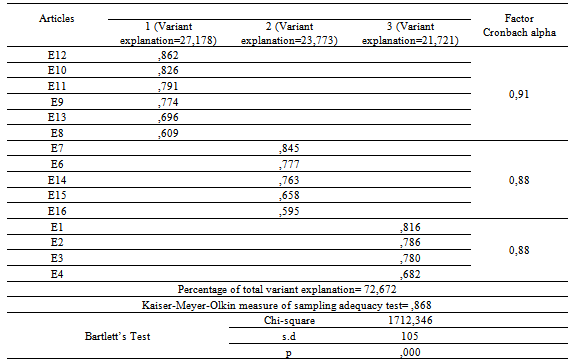 |
| |
|
Articles 1, 2, 3, 4 are classified as significance and importance (making the work meaningful and important); 6, 7, 14, 15, 16 as support (improvement, education and resource); 8. 9. 10. 11. 12 and 13 as free will and providing freedom (granting initiative, participation in the decision making process). Table 3. Results of the factor analysis for organizational cynicism (Varimax rotation is used)
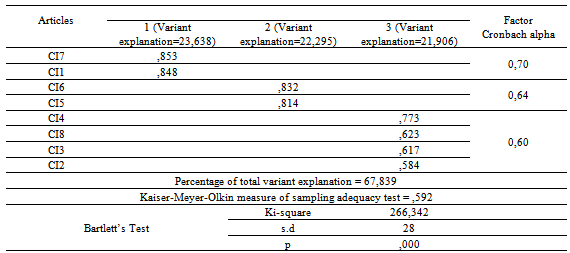 |
| |
|
Although the scale for organizational cynicism has presented a 3-factor structure it is taken into consideration as a single-factor structure in the available literature. Table 4. Socio-demographic and occupational features of the participants
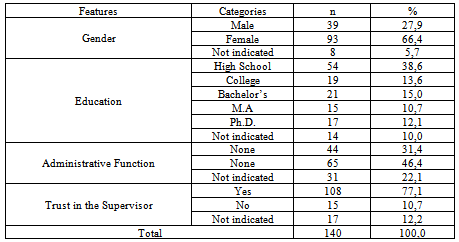 |
| |
|
66,4% of the participants are women, 38,6% are high school graduates and 46,4% do not have an administrative function and 77,1% trust their supervisors. Table 5. Central and extensity criteria for organizational cynicism and personnel empowerment and the participants’ ages and the period they have been working for the institution
 |
| |
|
The average age of the participants is 33,25 + (9,84), the average organizational cynicism is 2,63+/-(0,81) and the average personnel empowerment is 4,08 +/- (1,01). Median for the period of time spent in the institution is 2,00 and median for the period the participants are performing their job is 6,00. Table 6. Correlation between organizational cynicism and personnel empowerment (Pearson’s Correlation test is applied)
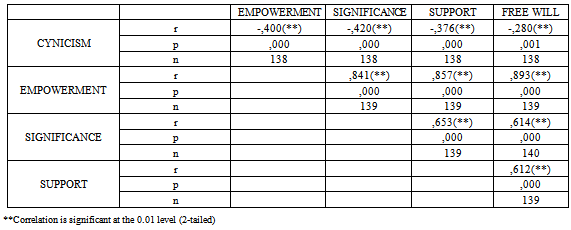 |
| |
|
When the correlation between the participants’ organizational cynicism and personnel empowerment is evaluated it has been observed that the general score for empowerment is correlated in a negative direction and at a medium level with significance and support and in a negative direction and at a weak level with free will (p<0,05). Table 7. Regression analysis for organizational cynicism and personnel empowerment
 |
| |
|
Y=3,935-0,320x in other words organizational cynicism=3,935-0,320personnel empowermentWhen the regression analysis between organizational cynicism and personnel empowerment is evaluated it has been observed that empowerment explains 0,16 of cynicism. It is obvious in the model that personnel empowerment affects cynicism with the coefficient of -0,32 and according to this finding the regression equation is:Y=3,935-0,320x in other words organizational cynicism=3,935-0,320personnel empowerment | Figure 1. Personnel empowerment and organizational cynicism scatter gram and regression line |
6. Conclusions
Personnel empowerment means in brief, granting power and authority to employees. Empowerment also motivates and energizes the employees. Organizational cynicism can be considered as the negative attitude of the employee against the employing institution. The main three elements of organizational cynicism can be summarized as belief in the fact that the organization lacks honesty, negative feelings towards the organization and expressions stating the dishonesty and insincerity of the organization. Among the reasons for the occurrence of organizational cynicism disposition, violation of the psychological contract and deficiencies in the leadership behavior can be given. In this research the relationship between organizational cynicism which is in fact a negative factor in the institutions and personnel empowerment is evaluated. 66,4% of the participants are women, 38,6% are high school graduates and 46,4% do not have an administrative function and 77,1% trust their supervisors. When the correlation between the participants’ organizational cynicism and personnel empowerment is evaluated it has been observed that the general score for empowerment is correlated in a negative direction and at a medium level with significance and support and in a negative direction and at a weak level with free will. When the regression analysis between organizational cynicism and personnel empowerment is evaluated it has been observed that empowerment explains 0,16 of cynicism.At the end of the research it has been determined that there is a relationship between personnel empowerment and organizational cynicism. Personnel empowerment which is believed to enhance employee motivation and have a positive impact on the employees should also be evaluated from this perspective. The issue of personnel empowerment should seriously be taken into consideration in businesses.
References
| [1] | Fred Luthans, Organizational Behaviour, McGraw Hill, New York, 1992. |
| [2] | David Krackhardt, Assesing The Political Landscape: Cognition, and Power Organizations, Administrative Science Qarterly, New York, p.343 |
| [3] | Michael Donovan, The Empowerment Plan, Journal for Quality and Participation, p.12 |
| [4] | Ken Blanchard, John Carlos, Alan Randolph, Empowerment Takes More Than a Minute, Berrett-Koehler Publishers, San Fransisco. P.56 |
| [5] | J.A. Conger ve R.N.Kanungo, “The Empowerment Process: Integrating Theory and Practice,” Academyof Management Review, Volume No:13, Edition No:3, (1988), p.472; Gretchen M. Spreitzer, “Psychological Empowerment in the Workplace: Dimensions, Measurement. |
| [6] | Tamer Kocel, İşletme Yöneticiligi, Arıkan Yayınları, Istanbul, 2005, p.414-416 |
| [7] | M. Gökberk, Felsefe Tarihi, Remzi Kitapevi, Istanbul, 2000.; 48, Hançerlioğlu, O., Düşünce Tarihi. Remzi Kitapevi, Istanbul, 1999, p.76 |
| [8] | James, M.S.L., Antecedents And Consequences Of Cynıcısm In Organızatıons: An Examınatıon Of The Potentıal Posıtıve And Negatıve Effects On School Systems (Dissertation of Doctor of Philosophy), The Florida State University, Florida, 2005, p.7 |
| [9] | Ersin Şirin, İlköğretim Okullarındaki Öğretmenlerin Okul Kültürü Algıları İle Örgütsel Sinizm Tutumları Arasındaki İlişki (İstanbul İli Esenyurt İlçesi Örneği), Yeditepe Üniversitesi Sosyal Bilimler Enstitüsü, Eğitim Yönetimi ve Denetimi Anabilim Dalı, İstanbul-2011, p.28; quoted by Dean vd. (1998), Stanley vd. (2005); Akt.Tokgöz ve Yılmaz (2008). |
| [10] | P.H. Mirvis, and Kanter, D.L., “Beyond Demography: A Psychographic Profile of The Workforce”, Human Resource Management, 30 (1), (1991), p.61 |
| [11] | M.L. Andersson. (November, 1996). Employee cynicism: An examination using a contract violation framework. Human Relations, Vol. 49, No. 11; 1403, p.1403 |
| [12] | W.J. Dean, P. Brandes and R. Dharwadkar. (1998), Organizational Cynicism. Academy of Management Review, Vol. 23, No. 2., p.343 |
| [13] | D. Kanter and P. Mirvis (1991). Cynicism: The New America Malaise. Business and Society Rewiew. Spring, p. 59 |
| [14] | M. Brown and Christina Cregan, Organizational Change and Cynicism: The Role of Employee Involvement, Human Resource Management, Winter-2008, Vol:47, No.4, p.668-669 |
| [15] | Oya İnci Bolat, Tamer Bolat ve Oya Aytemiz Seymen, Güçlendirici Lider Davranışları ve Örgütsel Vatandaşlık Davranışı Arasındaki İlişkinin Sosyal Mübadele Kuramından Hareketle İncelenmesi, Balıkesir Ünv. Sosyal Bilimler Enstitüsü Dergisi, Vol:12, No:21, 2009, p.215-239 |
| [16] | Gamze Kalağan, Cem Oktay Güzeller, Öğretmenlerin Örgütsel Sinizm Düzeylerinin İncelenmesi, Pamukkale Üniversitesi, Eğitim Fakültesi Dergisi, Sayı:27, 2010, p.83-97. |

 While defining the concept of organizational cynicism, Mirvis and Kanter pointed out the fact that organizations can be cynical as well. They described cynical organizations as “organizations which apply deceptive and exploitive implementations, develop unilateral relations with their employees, behave in a quick-tempered manner, support administrators who follow a hypocritical policy against their employees and materialize values selfishly.”[10]Types of Cynicisma) Dispositional CynicismDispositional cynicism is the pathopsychological variable of organizational cynicism. This type of cynicism is also figured in “Cook-Medley Hostility Scale”. This invariable idiosyncrasy is defined as cynicism against any kind of human behavior (Dalken, 2004: 17). In dispositional cynicism the person behaves hostile towards others and question people’s attitude towards himself even if they have good intentions. b) Employee CynicismEmployee cynicism is mainly targeted against big capital owners, senior management and other persons or departments in the work place. The feeling of inequality separates the cynical employee from other employees. This feeling of inequality occurs when the formal employment contract between the employer and the employee is violated as in the violation of psychological contracts between the employer and the employee, which implicitly promise equality, justice and objectivity[11]. c) Work CynicismWork (Occupational) Cynicism is usually associated with service sector personnel who are believed to experience clash of roles and uncertainty about their roles[12].d) Social CynicismSocial or Institutional cynicism is about the distrustful attitude of citizens against their states or institutions. Social/Institutional cynicism occurs as a result of the violation of the psychological contract between the individual and the society[13].e) Organizational Change CynicismCynicism about organizational change is defined as “pessimistic views about the efforts of organizations to change and reach the targeted success”[14].f) Organizational CynicismOrganizational cynicism is usually associated with the employees’ excessively negative attitudes towards the employing organizations. In organizational cynicism the employee despises the management, accuses it of selfishness, insults and despises his or her colleagues (Dean and others, 1988: 345).
While defining the concept of organizational cynicism, Mirvis and Kanter pointed out the fact that organizations can be cynical as well. They described cynical organizations as “organizations which apply deceptive and exploitive implementations, develop unilateral relations with their employees, behave in a quick-tempered manner, support administrators who follow a hypocritical policy against their employees and materialize values selfishly.”[10]Types of Cynicisma) Dispositional CynicismDispositional cynicism is the pathopsychological variable of organizational cynicism. This type of cynicism is also figured in “Cook-Medley Hostility Scale”. This invariable idiosyncrasy is defined as cynicism against any kind of human behavior (Dalken, 2004: 17). In dispositional cynicism the person behaves hostile towards others and question people’s attitude towards himself even if they have good intentions. b) Employee CynicismEmployee cynicism is mainly targeted against big capital owners, senior management and other persons or departments in the work place. The feeling of inequality separates the cynical employee from other employees. This feeling of inequality occurs when the formal employment contract between the employer and the employee is violated as in the violation of psychological contracts between the employer and the employee, which implicitly promise equality, justice and objectivity[11]. c) Work CynicismWork (Occupational) Cynicism is usually associated with service sector personnel who are believed to experience clash of roles and uncertainty about their roles[12].d) Social CynicismSocial or Institutional cynicism is about the distrustful attitude of citizens against their states or institutions. Social/Institutional cynicism occurs as a result of the violation of the psychological contract between the individual and the society[13].e) Organizational Change CynicismCynicism about organizational change is defined as “pessimistic views about the efforts of organizations to change and reach the targeted success”[14].f) Organizational CynicismOrganizational cynicism is usually associated with the employees’ excessively negative attitudes towards the employing organizations. In organizational cynicism the employee despises the management, accuses it of selfishness, insults and despises his or her colleagues (Dean and others, 1988: 345).
 Abstract
Abstract Reference
Reference Full-Text PDF
Full-Text PDF Full-text HTML
Full-text HTML




